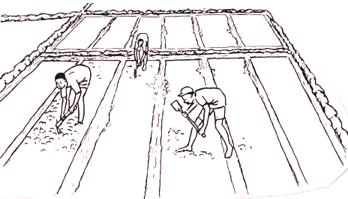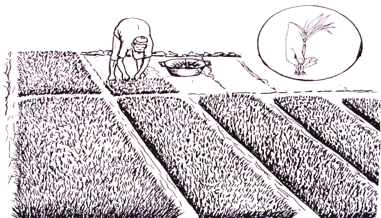A good seedling nursery produces vigorous seedlings. Below describes how to install and manage a nursery, from the soaking of the seed to removing of the seedinligns ready for transplanting.
Seed pre-germination
Pre-germination involves two distinct steps, i.e. soaking and incubation. Soaking means that seeds are soaked in a not too tight cloth or jute bag for 24 hours. Soaking allows the grain to absorb the quantity of water that is necessary to trigger germination. Incubation means that the seeds are withdrawn from the water and kept in a ventilated place, at a temperature close to 30° C, until they germinate, usually after 24 to 36 hours.
Preparation of the nursery

The nursery is prepared like the rice field itself, but with some extra care. Avoid clayey soil to facilitate the removal of seedlings, but the nursery should also not be too sandy, to prevent seedlings from drying out too easily. If clayey soils are used, it is advisable to spread a thin layer of sand (about 1 cm) on the sowing bed to facilitate the pulling of the seedlings that are ready to be transplanted.
After puddling and leveling the area that will be used for the nursery, 1m x 10m seedling beds (about 5 to 10 cm high) are constructed, separated by irrigation canals. Canals surrounding the nursery beds (30 to 40 cm wide) serve as pathways for transplanters to pull the seedlings, and as a barrier against depredators.
Nursery site
The nursery must be installed in an accessible and sunny place, close to the rice fields and to the water source, sheltered from animals and birds. Avoid installing nurseries in the shade of trees as this will weaken the seedlings.
Sowing density
In order to obtain vigorous seedlings to transplant, it is recommended to sow approximately 0.2 kg of seeds per m2 to reach the appropriate density. A 2500 m2 field can be transplanted with the seedlings from a 50 m2 nursery, which is five 10 m2 beds, which will require 10 kg of seeds.
To obtain a good density at emergence, the following measures are recommended:
-
Make sure that good quality seeds are used (germination test).
-
Install the nursery on appropriate soil, well plowed and well leveled.
-
When sowing, it is important to throw the grains with force into the sowing bed to fix them in the mud, thus preventing them from being carried away by the irrigation water.
-
Make sure that irrigation is well managed and protect the beds from birds, animals and any other depredators.
Seedling age
Seedling age at transplanting depends on the season and on the characteristics of the plot. It is usually recommended to transplant 2 to 3 week old seedlings during the rainy season, because the climate conditions will allow them to develop fast. However during the dry season, 3 to 5 week old seedlings are recommended for transplanting, because plant growth will be reduced by cold temperatures. When water control and leveling are relatively poor, which is often the case in non-developed inland valleys, it is advisable to transplant 4 to 5 week old seedlings in order to avoid damage by flooding.
Nursery water management
It is essential that the nursery never dries out but, excess water will lead to weak seedlings that are too tall. Prolonged flooding may cause seedling death. The canals surrounding the sowing beds allow draining the nursery while maintaining humidity. With good water control, the following recommendations may be followed to irrigate a nursery:
-
Sow on drained soil. (Bring water back only 2 or 3 days later, to give the roots enough time to fix in the soil).
-
Maintain water level at 2 to 3 cm for 10 days.
-
Drain the plot for 24 to 48 hours.
-
Progressively raise the water level until seedlings are pulled for transplanting (5 cm).
During the dry season, it is advisable to drain the plot in the evening to avoid exposing the young seedlings to low water temperatures during the night. Irrigation is resumed rather late the next morning to let seedlings benefit from the sun.
When the nursery is installed in a place where it is not possible to irrigate, water cans can be used. The soil must be kept humid until emergence (for 3-4 days) and then progressively increase the number of water cans. In general, in such cases, hand weeding becomes necessary and this should be done approximately ten days after sowing.

Nursery fertilization
In case of poor soil fertility, or during the dry season, when growth is slower, it is recommended to apply nitrogen – about 10 g of urea per m2 – as top dressing, at about two weeks after sowing.
Pulling seedlings
Pulling rice seedlings is a delicate operation that is too critical to be left to children (which is often the case) or to paid outside labor (always wanting to finish the job quickly). If done without care, roots will be damaged, which may lead to substantial yield loss (‘missing hills’) or the need to re-transplant such missing hills.
Seedlings should be pulled under water and, to avoid damage, the following technique is recommended:
-
Hold two or three rice seedlings between thumb and index finger, positioning the index almost perpendicular, and the thumb parallel to the seedlings.
-
Exert a low pressure downwards before slowly pulling the seedling toward oneself. Be careful to hold the seedlings close to the root.

Extract from: PLAR-IRM Curriculum: Technical Manual (Wopereis et al., 2009).













